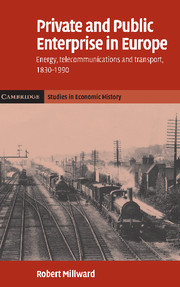Book contents
- Frontmatter
- Contents
- List of figures
- List of tables
- Preface
- Glossary and abbreviations
- Map: The European economy in 1914
- Part I Introduction
- Part II The Construction of the New European Infrastructure c. 1830–1914
- Part III Nations and Networks c. 1914–1945
- Part IV State Enterprise c. 1945–1990
- 10 The new state, economic organisation and planning
- 11 Coal, oil and security
- 12 Airline regulation and the transport revolution
- 13 Telecommunications 1950–1990: from calm to storm
- 14 Economic policy, financial accountability and productivity growth
- Part V Conclusions
- Appendix: Infrastructure service levels and public ownership c. 1910: a statistical analysis
- Bibliography
- Index
10 - The new state, economic organisation and planning
Published online by Cambridge University Press: 14 July 2009
- Frontmatter
- Contents
- List of figures
- List of tables
- Preface
- Glossary and abbreviations
- Map: The European economy in 1914
- Part I Introduction
- Part II The Construction of the New European Infrastructure c. 1830–1914
- Part III Nations and Networks c. 1914–1945
- Part IV State Enterprise c. 1945–1990
- 10 The new state, economic organisation and planning
- 11 Coal, oil and security
- 12 Airline regulation and the transport revolution
- 13 Telecommunications 1950–1990: from calm to storm
- 14 Economic policy, financial accountability and productivity growth
- Part V Conclusions
- Appendix: Infrastructure service levels and public ownership c. 1910: a statistical analysis
- Bibliography
- Index
Summary
As 1945 drew to a close, Europeans looked to the future rather than the past. There was to be no return to pre-war conditions. They were not glorified as the nineteenth-century world had been in the immediate aftermath of the First World War. By 1945, France was determined to avoid any repeat of the three German invasions since 1870. The defeated nations, Germany and Italy, rejected the past. Elsewhere in parts of Scandinavia, the UK and the Low Countries, there was more pride in the outcome of the war, but what they shared with France, Germany and Italy was the memory of the economic conditions of the inter-war period and a need to repair the physical damage from the war.
The credibility of capitalism was in question. The high unemployment levels of the 1930s, the collapse of banking systems, crises on stock exchanges and exchange rate instability meant that management of the macro-economy became a prime responsibility of government. The plight of the poor in the 1930s and the social intermingling during the war put pressures on government to adopt explicit policies for raising the living standards of lower-income groups. The war was a collective effort, and a ‘one nation’ philosophy pervaded many postwar governments. It was unlikely, moreover, that reconstruction would be left to the market. Shifting resources from military to civilian use would mean wild movements in prices and the prospect for some of juicy profits and rents for resources in inelastic supply.
- Type
- Chapter
- Information
- Private and Public Enterprise in EuropeEnergy, Telecommunications and Transport, 1830–1990, pp. 171 - 207Publisher: Cambridge University PressPrint publication year: 2005

